ASRock M8 Barebones Review: My Steam Box
by Ian Cutress on January 2, 2014 10:00 AM EST- Posted in
- Barebones
- Intel
- ASRock
- Motherboards
- Cases/Cooling/PSUs
- Z87
Because it can be difficult to benchmark a barebones, due to our choice in hardware overriding any performance results, I wanted to run my usual CPU benchmark suite to at least indicate where a CPU such as the i7-4765T would perform, given its lower CPU MHz base (2.0 GHz) but highly multithreaded nature. The CPU itself performs well, and outstretches almost all the AMD CPUs in every benchmark, sometimes being eclipsed by the FX-8350 in specific workloads.
Point Calculations - 3D Movement Algorithm Test
The algorithms in 3DPM employ both uniform random number generation or normal distribution random number generation, and vary in various amounts of trigonometric operations, conditional statements, generation and rejection, fused operations, etc. The benchmark runs through six algorithms for a specified number of particles and steps, and calculates the speed of each algorithm, then sums them all for a final score. This is an example of a real world situation that a computational scientist may find themselves in, rather than a pure synthetic benchmark. The benchmark is also parallel between particles simulated, and we test the single thread performance as well as the multi-threaded performance.
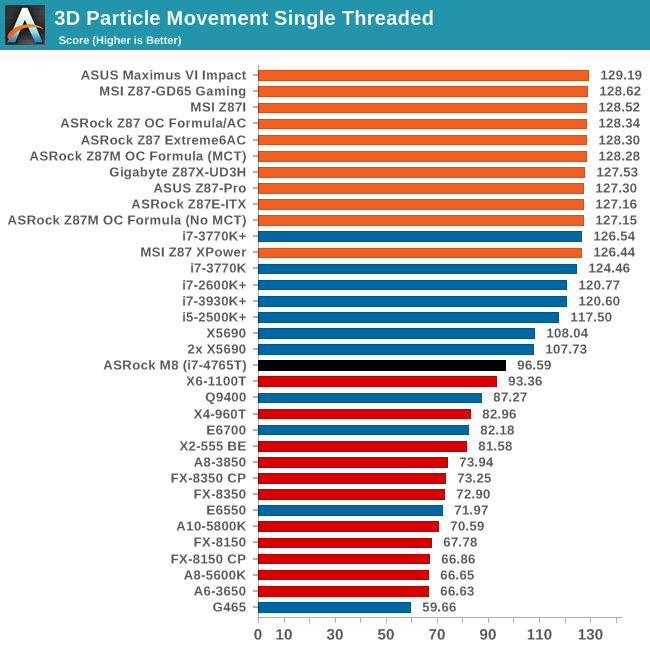
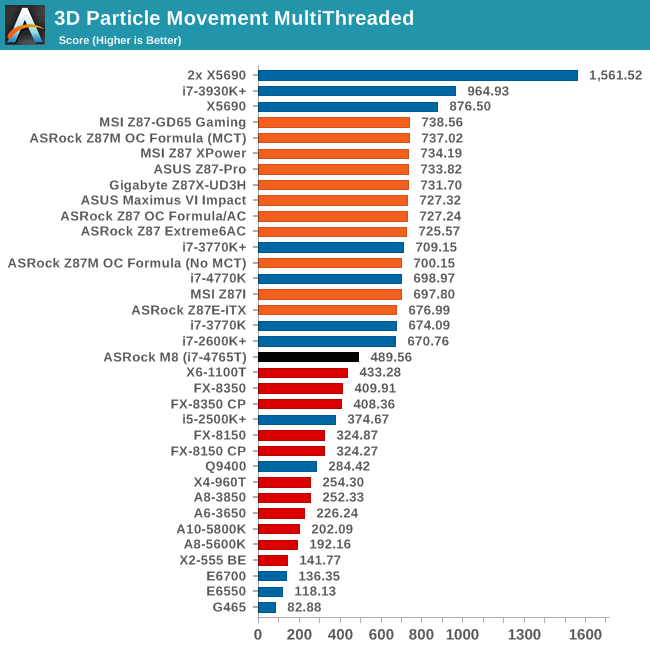
Compression - WinRAR 4.2
With 64-bit WinRAR, we compress the set of files used in the USB speed tests. WinRAR x64 3.93 attempts to use multithreading when possible, and provides as a good test for when a system has variable threaded load. WinRAR 4.2 does this a lot better! If a system has multiple speeds to invoke at different loading, the switching between those speeds will determine how well the system will do.

Image Manipulation - FastStone Image Viewer 4.2
FastStone Image Viewer is a free piece of software I have been using for quite a few years now. It allows quick viewing of flat images, as well as resizing, changing color depth, adding simple text or simple filters. It also has a bulk image conversion tool, which we use here. The software currently operates only in single-thread mode, which should change in later versions of the software. For this test, we convert a series of 170 files, of various resolutions, dimensions and types (of a total size of 163MB), all to the .gif format of 640x480 dimensions.
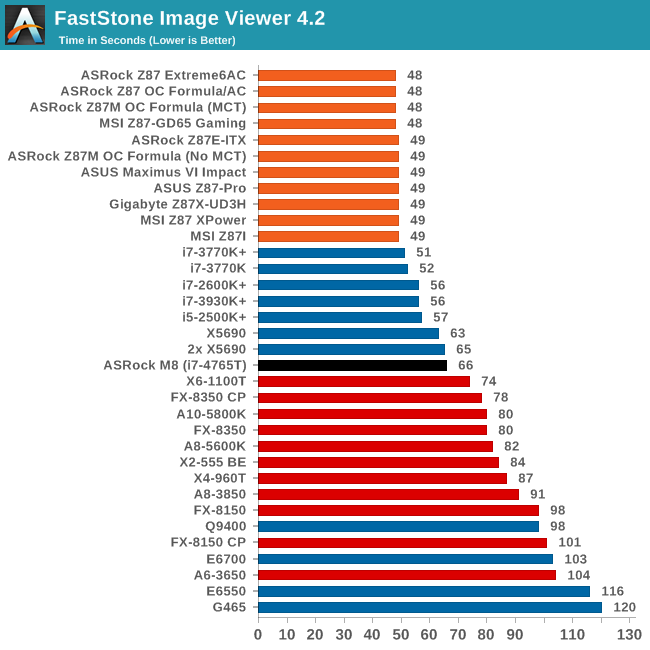
Video Conversion - Xilisoft Video Converter 7
With XVC, users can convert any type of normal video to any compatible format for smartphones, tablets and other devices. By default, it uses all available threads on the system, and in the presence of appropriate graphics cards, can utilize CUDA for NVIDIA GPUs as well as AMD WinAPP for AMD GPUs. For this test, we use a set of 33 HD videos, each lasting 30 seconds, and convert them from 1080p to an iPod H.264 video format using just the CPU. The time taken to convert these videos gives us our result.
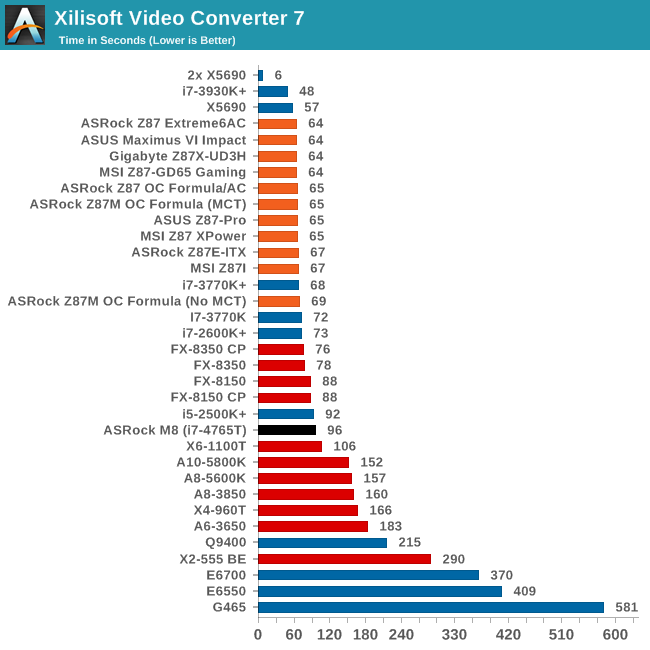
Rendering – PovRay 3.7
The Persistence of Vision RayTracer, or PovRay, is a freeware package for as the name suggests, ray tracing. It is a pure renderer, rather than modeling software, but the latest beta version contains a handy benchmark for stressing all processing threads on a platform. We have been using this test in motherboard reviews to test memory stability at various CPU speeds to good effect – if it passes the test, the IMC in the CPU is stable for a given CPU speed. As a CPU test, it runs for approximately 2-3 minutes on high end platforms.

Video Conversion - x264 HD Benchmark
The x264 HD Benchmark uses a common HD encoding tool to process an HD MPEG2 source at 1280x720 at 3963 Kbps. This test represents a standardized result which can be compared across other reviews, and is dependent on both CPU power and memory speed. The benchmark performs a 2-pass encode, and the results shown are the average of each pass performed four times.
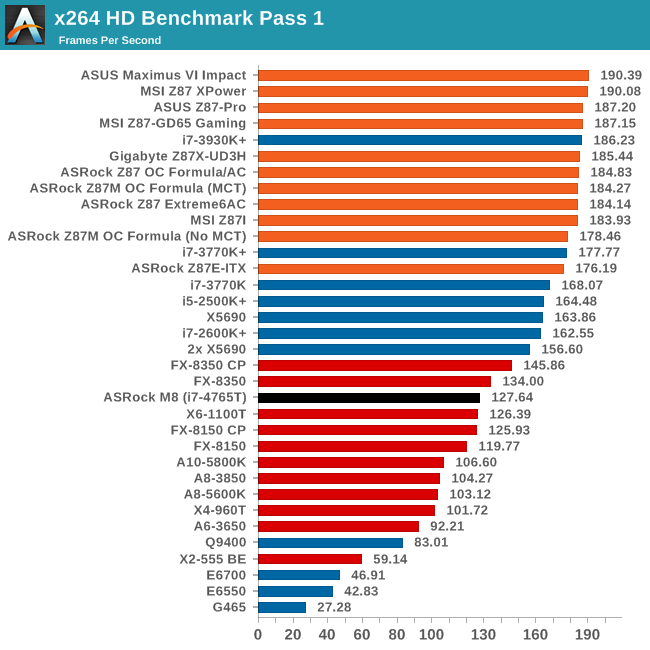
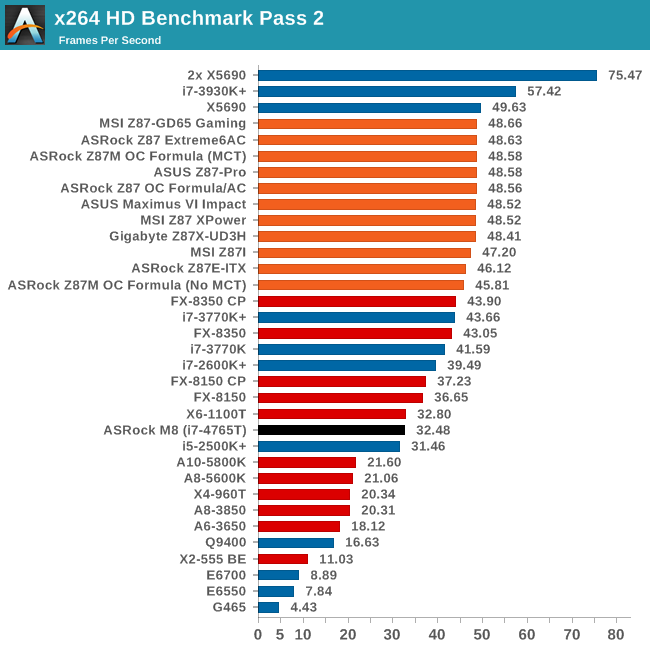
Grid Solvers - Explicit Finite Difference
For any grid of regular nodes, the simplest way to calculate the next time step is to use the values of those around it. This makes for easy mathematics and parallel simulation, as each node calculated is only dependent on the previous time step, not the nodes around it on the current calculated time step. By choosing a regular grid, we reduce the levels of memory access required for irregular grids. We test both 2D and 3D explicit finite difference simulations with 2n nodes in each dimension, using OpenMP as the threading operator in single precision. The grid is isotropic and the boundary conditions are sinks. Values are floating point, with memory cache sizes and speeds playing a part in the overall score.
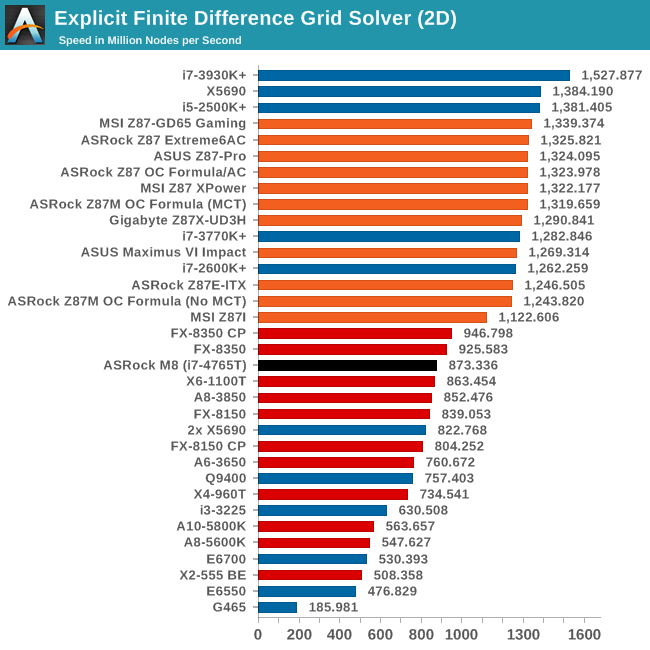
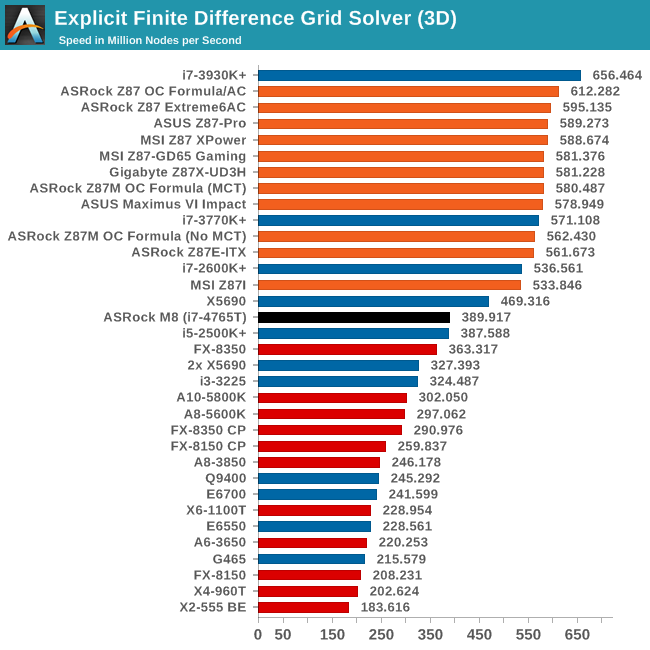
Grid Solvers - Implicit Finite Difference + Alternating Direction Implicit Method
The implicit method takes a different approach to the explicit method – instead of considering one unknown in the new time step to be calculated from known elements in the previous time step, we consider that an old point can influence several new points by way of simultaneous equations. This adds to the complexity of the simulation – the grid of nodes is solved as a series of rows and columns rather than points, reducing the parallel nature of the simulation by a dimension and drastically increasing the memory requirements of each thread. The upside, as noted above, is the less stringent stability rules related to time steps and grid spacing. For this we simulate a 2D grid of 2n nodes in each dimension, using OpenMP in single precision. Again our grid is isotropic with the boundaries acting as sinks. Values are floating point, with memory cache sizes and speeds playing a part in the overall score.
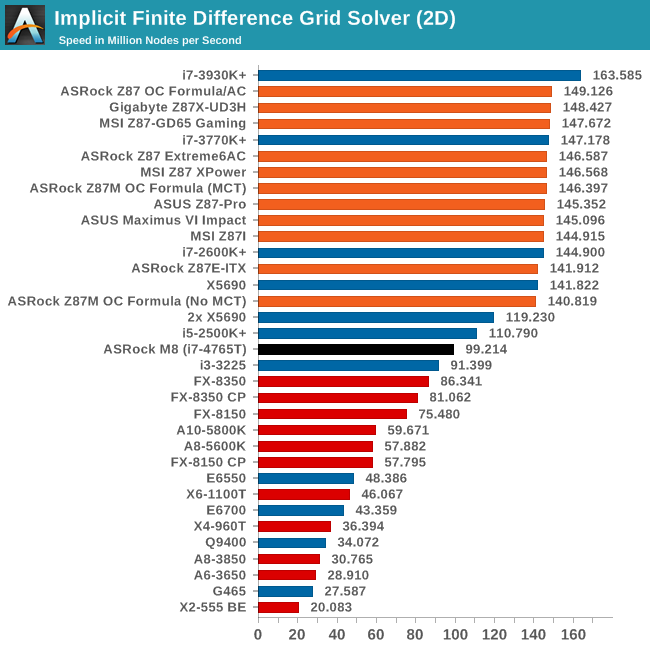
Point Calculations - n-Body Simulation
When a series of heavy mass elements are in space, they interact with each other through the force of gravity. Thus when a star cluster forms, the interaction of every large mass with every other large mass defines the speed at which these elements approach each other. When dealing with millions and billions of stars on such a large scale, the movement of each of these stars can be simulated through the physical theorems that describe the interactions. The benchmark detects whether the processor is SSE2 or SSE4 capable, and implements the relative code. We run a simulation of 10240 particles of equal mass - the output for this code is in terms of GFLOPs, and the result recorded was the peak GFLOPs value.
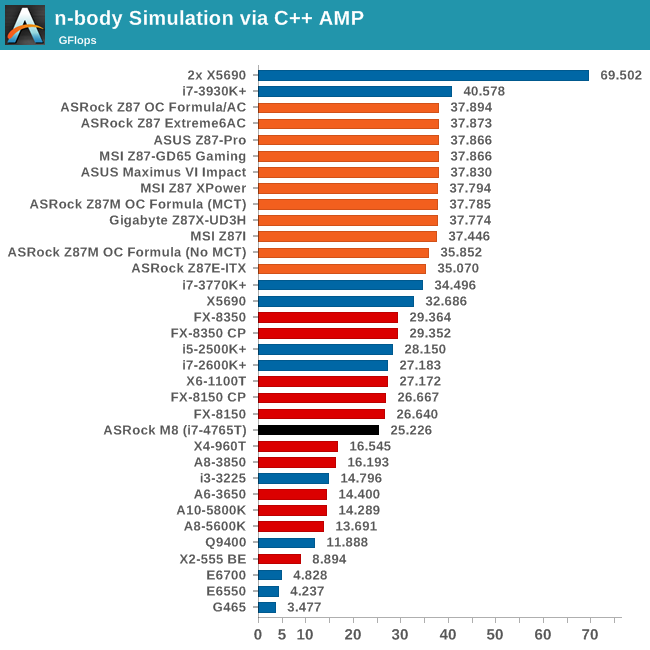










78 Comments
View All Comments
IanCutress - Friday, January 3, 2014 - link
How so? Please send me an email (ian AT anandtech DOT com) with suggestions and comments.Navvie - Friday, January 3, 2014 - link
BMW designed this? Clearly not the same guys who design their cars.... if their cars were this fugly, nobody would by them, ever.Also some of the sentence structures in this article are hard to read...
eg. "ASRock now come to the market with the M8 barebones based on a BMW design for the Z87 platform, at half the width of the Bitfenix Prodigy and a high build quality."
Makes me think the design for the case is based on BMW's design for the Z87. Some far off successor to their Z3 and Z4 cars.
"ASRock now come to the market with the M8, a barebones for their Z87 platform, designed by BMW." Would be better, but still not right.
CknSalad - Friday, January 3, 2014 - link
It's good to see the SFF market finally gaining much needed steam with intriguing products such as this one. That said, I honestly prefer small shoebox-sized cases like the sg05 or the small tower cases like the crowd-funded Ncase M1, which I actually currently own :D.I'm okay with mid-tower and full tower cases as there will always be a want/need for an enthusiast market, but the DIY desktop market really needs to start making a lot more M-Atx cases that are around the size of the Silverstone SG10 or TJ08-E. If more cases like the Asrock M8 come up, I'm sure that the desktop market will garner more interest from the Average Joe consumer.
ImSpartacus - Friday, January 3, 2014 - link
"The mini-ITX motherboard designed specifically for the chassis forgoes any significant power delivery and heatsink design, which is perhaps an oversight – for this build I went for a an i7 CPU but a low power 'T' model SKU so as not to overload or burn out the power delivery. ASRock state that the fans they supply below the motherboard help with the VRM cooling and thus nothing should stop a user placing an i7-4770K into the system, but overclocking longevity might be limited. I decided to apply some brain and use common sense for our test build here."This paragraph feels a little un-Anandtech.
I'm used to reasoned arguments supported by buckets of objective data. This paragraph feels further from that and closer to FUD territory.
Granted, I have no reason to agree or disagree with the point raised in that paragraph, but that's really the problem. For me, an Anandtech article educates its audience and let's the audience do most of the conclusion-determining.
kyuu - Saturday, January 4, 2014 - link
Can't say I agree. This is a tech blog, not a science journal. The writers' personal opinions and foibles come into play all the time, and that's fine.Death666Angel - Monday, January 6, 2014 - link
So he should have pushed the platform until it burns out to prove or disprove what they said? What exactly is the FUD part for you? Seems like he gave us the AsRock PR line and his assessment of it. Going much further would increase the cost and risk by quite a lot, something he probably thought was not needed, and I have to agree.ol1bit - Friday, January 3, 2014 - link
Seems pricey. I built a media/steam PC with Window 7 for much cheaper than that. Runs everything I want it to, plus is stylish. an i3, 4GB, Nivida 650.Case isn't made anymore, but can be seen here: http://www.amazon.com/gp/product/B000CQBISA/ref=oh...
Jonpet - Saturday, January 4, 2014 - link
What`s with that presentation? Please place common object for size reference in at least one photo!Thanks.CalaverasGrande - Saturday, January 4, 2014 - link
at that BOM it is almost getting into New Mac Pro price range.Though the comparable Mac would have less storage, but a better CPU and GPU (well...debatable).
It certainly would have faster ram and external connectivity.
Death666Angel - Monday, January 6, 2014 - link
How is 50% cheaper getting into Mac Pro price range?